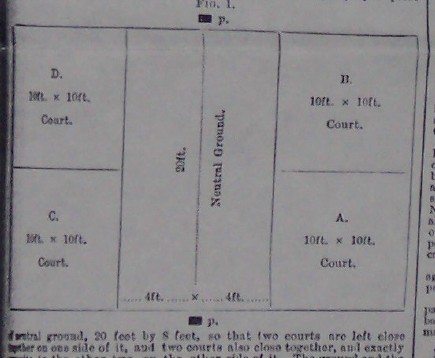
Origins of the Sport of Badminton
c: Letters from India 1873
The subject now has a rest for a few months - time for “The Field” to be carried to various centres in India, and for some very revealing replies to be sent back to the offices of that magazine.
The Field October 11th 1873 carried an article in its “PASTIMES” section, and the editorial introduction starts:
THE GAME OF BADMINTON. Several months since a correspondent inquired in our columns about the game of “Badminton”, and several letters were inserted in reply. A correspondent in India, seeing the inquiry, has now sent us a little pamphlet entitled “A Handbook of Badminton, with Rules for Playing the Game”, by Major Forbes, S.C., and published at Calcutta by the Great Eastern Hotel Company. A note accompanying the pamphlet, says “Your Indian readers will be glad to see a notice of these rules in your paper”
We think however, it will be of more interest to a larger number of our readers if we give them complete. People in England would hardly send to Calcutta for the rules, and residents in India will not be debarred by our publication from obtaining them in the much more handy form of the original pamphlet. We also give below a letter from a Nagpore correspondent on the same subject; and another set of rules, as adopted at Murree, in the Punjab, we must reserve for a future impression.
The whole pamphlet is then printed. It about 3000 words long, and contains 3 diagrams.
This is the earliest known set of rules, and must have had a reasonable circulation at least in Bengal. We shall refer to them as The Calcutta Rules.
Credit has never been given to the author, whom I believe to have been Major Henry Twisden Forbes, of the Bengal Staff Corps (S.C.)
His preface points out that a common set of rules ‘is sadly wanted’ all over the country (India). He admits that the size of his court, 28 ft long by 20 broad, is smaller than that generally in force, but says that it is fairer to ladies when playing against men, as it neutralises the greater strength and force of the latter. The net is 5 ½ ft, high, for the same reason. The playing area is divided into four service courts, with a neutral area in between, as it is today.
It is not practicable to show the entire handbook here, but a few comments seem in order.
Major Forbes says “Badminton may be considered as a kind of ‘Ladies’ Rackets’”, and hints that because of a strong similarity with rackets the rules are somewhat similar. They are also amazingly close to those of modern Badminton.

Note that the court is rectangular, with the net posts being on the sidelines. Other similarities to today’s game are:
Two hands per side in doubles
Spinning, or playing a hand, for first serve
Only one service at start of game
Only the serving side scores
Servers change courts after winning a point
Game is to 15 aces